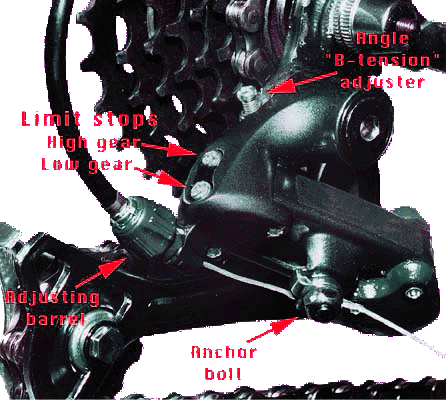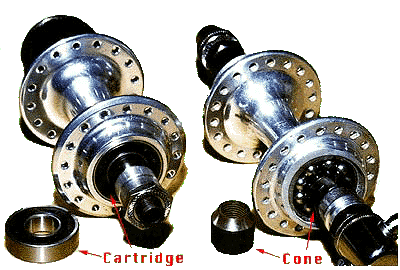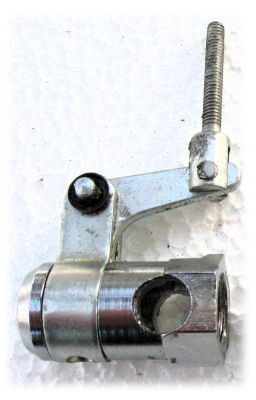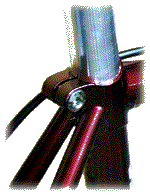Sheldon Brown's Bicycle Glossary Ba (original) (raw)
Opinions and value judgments are our own, unless otherwise noted
-- Sheldon (d. 2008), Harriet, John.
Additions and corrections are most welcome.
A - B - C - D - EF - G - H - IJKL - M - NO - PQ - R - S - T - UVWXYZ
Up to previous page

B-Tension Adjustment
Shimano terminology for the screw that regulates the tension of the upper-pivot spring of a rear derailer. It should be adjusted with the bicycle in its lowest gear. Loosening this screw allows the jockey pulley to swing up closer to the cluster, improving shifting.
If the B-tension is too loose, however, the jockey pulley will bump into the largest rear sprocket, causing noisy running and possible shifting problems.
See my article on Derailer Adjustment for more information on this and other derailer adjustments.

Back-pedal brake
British term for coaster brake.
Ball Bearing
A ball bearing is a type of bearing in which the turning part is connected to the non-turning part only by balls that roll between the two parts. Ball bearings are used in bicycle bottom brackets, freewheels, headsets, and hubs. They are also occasionally used in derailer pulleys and brake calipers.
Ball locking mechanism
A mechanism using bearing balls to lock a sun gear to the axle in a planetary gearing system, used in some Sturmey-Archer internal-gear hubs.


Balloon Tire
A wide, low-pressure tire, typically 2.125" (54 mm) wide. The development of balloon tires and "streamlined", curved-tube frames created a mini bike boom in the 1930s. These bicycles are pretty much indistinguishable from modern cruisers, and were the ancestors of the mountain bike, which was built around the popular-sized balloon tires.
Banana Seat
A type of seat popular on wheelie bikes, which extended well back from the seat post. The rear end of the seat was supported by an upside-down "u" shaped brace called a "sissy bar" which attached to the rear axle or to the rear fork ends. Some banana seats had spring suspensions built into the sissy bars.
Band brake
A brake which uses a flexible band wrapped around the outside of a brake drum. Also see our article about band brakes.
BAR
A unit of pressure, equal to the normal air pressure at sea level, 14.5 PSI or 100 KPa (KiloPascals.)
Bar Ends
Handlebar extensions which mount on the ends of a straight-ish mountain-bike style handlebar to provide extra hand positions.
Barcons ®
Sun Tour trademark for derailer shift levers which mount in the ends of (usually) drop handlebars, replacing the normal end plugs. More formally known as "handlebar-end shifters" or "bar-end shifters," but not simply as "bar ends."
Barrel Adjuster
See: Adjusting Barrel
Bassworm ®
A form of "helper spring" for rear derailers. This is a fitting which slips over the rear derailer cable just in front of where it disappears into the final loop of housing that leads to the derailer. It includes a length of rubber tubing. The cable runs down the middle of this tubing, and a setscrew clamps one end of the tubing to the cable. This serves two purposes:
- It completely seals this vulnerable entry point against schmutz thrown up by the front tire.
- The rubber tubing acts as a "helper spring" to retract the cable smartly when upshifting. This can provide better upshifting on any bicycle which upshifts sluggishly due to excessive friction or a derailer with a weak spring.
B.C.D.
 Bead
Bead
A hoop, usually of heavy steel cable, that forms one edge of a tire. Sometimes made of Kevlar ®; for lightness and foldability.
Bead Seat Diameter
The Bead Seat Diameter (B.S.D.) is the crucial dimension that determines whether a particular tire can fit onto a particular rim. It specifically refers to the "shelf"-like area inside the rim where the tire's bead sits.
The Bead Seat Diameter is the fundamental dimension used in the ISO/E.T.R.T.O. system of tire and rim sizing. This is the great virtue of that system, compared to all of the older systems that referred to the tire's outside diameter, with no specific reference to rim diameter or to the rim/tire interface.
See my Tire Sizing article for details.
Bearing
A bearing is the point of contact between a turning part and a non-turning part. A good bearing assembly has little or no play, and as little friction as possible.
Major bearings on a bicycle are the headset, the bottom bracket and the hubs. There are also bearings in brakes, pedals and freewheels.

Bearings used in bicycles are usually of the cup-and-cone type, but many newer bicycles use cartridge bearings.
Bearing ball
A steel ball that is part of a ball bearing assembly. Most front hubs use 10 3/16" balls on each side; Most rear hubs use 9 1/4" balls on each side. Most bottom brackets use 11 1/4" balls on each side.
Bearing balls are made in batches, and within a batch the size is very carefully controlled. From one batch to another, however, there can be a considerable variation in actual size of balls of the same nominal size. For this reason, balls from different batches should never be mixed in the same bearing.
Bearing balls come in several quality grades, designated by numbers. Grade 25 is the best that is available for bicycle applications. Grades 100, 200, even 300 are commonly used in bicycles.


Bellcrank
A linkage in the form of a right-angled lever, with the pivot at the corner. Shimano 3-speed hubs (and some Sturmey-Archer 5-speeds) use a bellcrank to translate a pull on the gear cable into a push on a loose-fitting pushrod that fits into the axle.
 |
 |
|---|---|
| A bellcrank used to shift a Sturmey-Archer 5-speed hub. | Sheldon Brown points out a bellcrank that rings a bell, Chevreuse, France, July, 1989. Photo by John Allen |
Belt Drive
From time to time toothed belts are proposed as an alternative to chain drive. A belt may be lighter than a chain, though the pulleys are wider and so, heavier than sprockets for a chain. The major advantage touted for this system is that it is cleaner than a chain.
There are serious disadvantages to this approach, however:
- Belts can't be opened and re-closed as chains can, so it is not possible to fit one to a standard diamond frame, unless you cut the frame open, because the belt has to be looped through the triangle formed by the right chainstay, right seat stay and seat tube.
- Belts can't be lengthened/shortened as chains can, making it difficult to customize the gearing by going to a different sprocket/chainring size.
- Belts bend instead of pivoting, and are less efficient than chains.
- Belts are stretchy. To avoid skipping, they have to be kept tensioned, further reducing efficiency.
- Belts can't be made as narrow as chains, so they do not lend themselves to derailer gearing.
As with shaft-drive systems, all of the benefits touted for this system are also attainable with an enclosed chain drive.
[Update, June 2012: Gates Carbon Drive carbon-fiber reinforced belts are currently in vogue. They don't stretch as much as other belts and so, don't have to be tensioned as much. However, carbon fiber is brittle, and these belts will soon snap if fibers have been damaged -- if the belt is "levered" onto a pulley from the side, or if a twig or trouser cuff is caught between the belt and a pulley. A Gates belt (and probably others) should be fitted over the pulleys loose, and tensioned by moving the pulleys farther apart, so the belt is subjected to stress only lengthwise, as in normal operation. -- John Allen]
Also see R&E Cycles comments on belt drive for the tandem synchronizing chain.
Bendix
A very old company, originally known as a maker of coaster brakes, but later diversified into the automotive industry, where they are particularly involved with starters. (The retractable drive gear on an automotive sprocket is commonly called a "Bendix gear".) The company is still going strong, but the bicycle division was sold off some years ago.


Benelux
A defunct British maker of derailers. These were popular in the middle of the 20th century. Benelux rear derailers used a telescoping assembly and conical return spring, and attached to the chainstay. Derailers with a pantograph (parallelogram) mechanism replaced these.
'Bent
Recumbent bicycle or tricycle.
Bento box
A small box strapped to the top tube and handlebar stem, generally carrying food. "Bento" is Japanese for "box lunch".
Bidon
French term for a water bottle.
Bike
Noun: bicycle; motorcycle. Many cyclists object to verb-based derivatives of "bike" i.e. "to bike", "biking", "biker"...(Bikers ride Harleys, people who ride bicycles are cyclists.)
Bike Boom
In the early-to-mid 1970's, bicycle sales boomed, after several decades when the bicycle was commonly regarded as a child's toy.
The Bike Boom was partly related to the Baby Boom, as Boomers were starting to enter adulthood in large numbers. Other factors were the popularization of 10-speed derailer-equipped bicycles, and increasing environmental awareness, with the hope that bicycling would substitute for much motoring. The bike boom is often attributed to the oil crisis of 1974, but in fact, it was already waning then -- see data in 1978 study republished by John Allen.
A similar bike boom had occurred in the mid-1890s when the safety bicycle with pneumatic tires replaced the high-wheeler.
It is important to distinguish bicycle sales from bicycle use. As bicycles are durable goods, a bike boom tends to saturate the market and then to be followed by a bust. The actual levels of bicycle use are more stable.*****
Billet
A solid chunk of metal, usually in the form of a slab or a piece of cylindrical stock. Commonly cut into usable parts by CNC machinery.
Binder Bolt 
Another name for a pinch bolt, usually used to refer to the seat-post bolt.
Binder bolts are also commonly used to clamp handlebars into the handlebar stem, and, in the case of threadless headsets, to clamp the stem to the fork steerer.
Biopace ®
A type of non-round chainwheel introduced by Shimano in the 1980's. It is designed to provide a more natural motion of the foot, better off-road traction, and to reduce stress on the knee.
See my article on Biopace for more details.


Blackwall Tire
Most tires use rubber blended with carbon black, which makes the tread more durable and improves traction.
In the 1950's, some tire companies started using "gum" rubber (without the carbon black) for the sidewalls, in the interest of improved flexibility and lowered rolling resistance. Later, "skinwall" tires became popular, tires with nearly naked cloth sidewalls, with just a bit of rubber to hold the cords together. For many years, tan sidewalls, whether gum or skin, were a sign of high-performance tires, and blackwalls were a sign of cheapness.
In the early 1990s, there was a styling fad for tires which were basically skinwalls, but looked like the old blackwalls. Although the marketing departments of tire companies tried to make this out as some kind of advantage, it is fundamentally a styling issue, as with whitewalls.
Blade
- One of the two "tines" of a front fork.
- A spoke that has been flattened in the direction of rotation for improved ærodynamics. "Bladed" spokes are so wide that they will not fit through the spoke holes of a standard hub flange. The usual solution to this problem is to file a notch or two to enlarge each spoke hole. This is very labor-intensive, and risks creating a stress riser which can lead to flange failure.
Block
- Short for freewheel block; cluster.
- "Brake block" is another term for a brake shoe or pad for rim brakes.
- A "block generator" is a combined generator/headlamp unit, designed to mount on the front fork. It has the advantage of not needing any wiring. Block generators are no longer generally available due to liability concerns. Since they mount to the fork blade, there exists a possibility that, if not properly secured, they could slip down and fall into the spokes, locking the front wheel and causing a crash.
- Block chain
Block Chain
An obsolete type of chain, formerly popular with track racers.
Block chain had solid blocks as inner links, without rollers. It had a 1" pitch with 3/16" wide blocks, the same as the "skip link" roller chain that appeared on the market about 1930 to replace it.
The remaining stock of block chain was coveted by track riders who believed it was the only chain strong enough to withstand their imagined strength. When the stock of block chains finally ran out in the late 1970's, it was replaced by 1/2" pitch 3/32" wide chain, as used with derailers, although track riders still prefer a 1/8" wide chain, believing they are stronger than other riders. MTB's with 22 tooth granny chainwheels produce several times the chain tension any track rider can muster.

An 8-tooth sprocket for 1" pitch chain (left) is equivalent to a 16 for standard 1/2" chain.
BMX
Bicycle Motocross, a type of dirt-track racing, primarily for children and teenagers. Competitors usually ride 20" wheel, single speed bicycles with a freewheel and a rear hand brake. Races, called "motos" usually last less than two minutes, and feature jumps. High-level BMX races mostly hinge on getting a good start off the line, which, for some reason, is called a "hole shot" BMX tracks use mechanical starting gates that fall forward under the riders' wheels when released.

Down to next page
A - B - C - D - EF - G - H - IJKL - M - NO - PQ - R - S - T - UVWXYZ


Articles by Sheldon Brown and Others
- What's New
- Beginners
- Bicycle Glossary
- Brakes
- Commuting
- Cyclecomputers
- Do-It-Yourself
- Essays and Fiction
- Family Cycling
- Fixed-Gear
- Frames
- Gears and Drivetrains
- Humor
- Old Bikes
- Repair Tips
- Singlespeed
- Tandems
- Touring
- Video
- Wheels
- Translations
- Sheldon - the man
Copyright © 1996, 2008 Sheldon Brown
Harris Cyclery Home Page
If you would like to make a link or bookmark to this page, the URL is:
http://sheldonbrown.com/gloss\_ba-n.html
Last Updated: by Harriet Fell